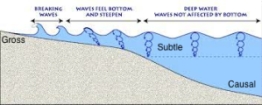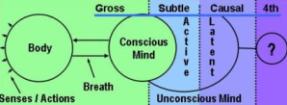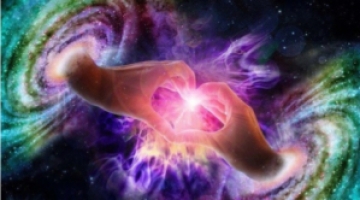In previous posts, we learned of two independent paths of evolution: growing up and waking up. We’re told that we don’t need yoga, rituals or gurus to wake up any longer. Instead we need to become our own gurus and learn to meditate to increase our own base frequency. But some people working on their own may be unaware or ill prepared to navigate through some deeper phases of the meditative path. What is old and new about meditation?
“Meditation is not what you think, for it is beyond thinking.” – Swami Rama
What is meditation?
Meditation means quieting or resting the mind. It’s not the same as thinking, contemplating, daydreaming or fantasizing. It’s about letting go, relaxing the body, becoming aware of the breath and thoughts, attending to them by witnessing them, but not reacting to them.
- Ram Dass said the ego will try to keep you busy with endless thought forms. But your thoughts are not who you are. You’re simply watching them until they dissolve.
- Eckhart Tolle said it’s like being a host at a large dinner party, where the guests are your thoughts. Your job is to greet them as they come in, but since you don’t have time to engage with each one, you let them pass and move on.
Meditation has been practiced in various forms for thousands of years. Nowadays meditation, deep breathing exercises and yoga are part of complementary medicine used to relieve stress, pain, anxiety, insomnia, depression, fatigue, and many other conditions (NIH study).
What types of meditation are there?
There are several types of meditation and relaxation technics. What differentiates them is the depth of meditation and the focal point or object of attention, as described by Swami Jnaneshvara Bharati.
- The focal point could be breath, sensation (touch/seeing), energy (chakras), attitudes (love/nonviolence/compassion), mantra, visualized images, or stream of thoughts.
- Some schools teach surface meditation, which is a method of relaxation (gross plane, below). Other practices reach much deeper states (subtle/causal/4th) in the ocean of consciousness. Meditation evolves in several stages described in detail at: SwamiJ.com.
You can meditate whether you’re sitting (straight back chair/cushion on the floor), lying down, walking, or engaging in activities, such as reflecting on sacred texts, listening to inspiring music, praying, etc. You can do it on your own or go to classes led by trained instructors.
What is good about meditation?
Judson Brewer, MD, PhD, studied the brain activity of experienced vs. novice meditators using functional MRI (below, left) to give them real-time feedback in their mindfulness practice.
- He found that meditation deactivated specific parts of the brain (below, right) that are all about the self, i.e. self-referential stuff. We spend about 50% of our waking lives just thinking about ourselves, but meditation dampened that.
- Amazingly, some of these novices learned to meditate in only 9 minutes! Their brain scans were identical to those of experienced meditators (with over 10,000 hrs practice).
Image: Functional MRI images of brain
By using the feedback, the novices learned to notice the difference between thinking about the breath vs. feeling it physically. They learned to be in a relaxed, receptive mode (not pushing anything) when being mindful. It was a great learning tool for them! For a great interview about contemplative science, please see: BG 259: Mapping the Mindful Brain – Buddhist Geeks.
Is meditation safe?
Meditation is considered safe for most people, if it’s done properly. But some people may react differently or overdo it, going too long or too deep too soon (e.g. novices on retreats).
- The shadow side of meditation has been studied by Willoughby Britton (“The Dark Night Project”) and others, who described meditators that became impaired (e.g. fearful, anxious, confused, disoriented, manic, depressed, or suicidal, etc.).
- Some of them recovered in less than a year. Others were impaired for several years.
People prone to dissociative or depersonalization disorders or other psychiatric problems should consult a professional before starting a meditative practice.
What is the dark night of the soul?
The term was coined by St. John of the Cross, a Catholic mystic in 16th century Spain. He described the path followed by the soul on its spiritual journey towards union with God.
- The dark night phase is characterized by a sense of abandonment, fear, doubt, anger, despair and frustration. It arises from the release of stored emotions, hidden memories and themes from the past, such as abandonment, rejection, etc.
- This happens when we begin to meditate below the surface level and dive deeper into the vast unconscious mind, that stores all the past experiences that need to be purified.
- Many traditions (e.g. Christianity, Buddhism, Judaism, Sufism, etc.) describe similar paths of spiritual development, that include a difficult or painful stage at some point.
A Buddhist teacher, Shinzen Young, said that almost everyone who gets anywhere with meditation will pass through periods of negative emotion, confusion, disorientation, etc., which can be managed with the help of a teacher, but may take months or years to resolve.
What did Mother Teresa’s soul say from the Other Side?
In “Talking with Twentieth-Century Women,” Peter Watson Jenkins and Toni Ann Winninger interviewed the soul of Mother Teresa about her depression that lasted over 50 years.
- In that life, her definition of God was a man in a white robe, a father figure or energy outside of her always directing and taking care of everyone.
- She prayed and yearned for contact with God outside of her. She felt abandoned, not wanted by God, and doubted that God existed. She was angry and frustrated.
“My despair felt as if I were but a single person floating alone in an ocean. I knew that there was other life around me in the water, but none of it interacted with me. It was as if I had been placed in a purgatory.” – Mother Teresa
Her life lesson was doubt, abandonment, and a call to go within – which in human form, she didn’t accomplish. She never saw the God-force inside and all around her, as it truly was.
“Never once did anybody say: Go inside of yourself. Find your soul. Had I done that, I would have had everything I sought.”
She said our search is always to connect to our soul, learn the lessons, and not have to do them again. Her advice is: “Go into your heart. Search for the unconditional love that is there. Latch onto that love, that part that connects you to the whole, and then and only then, from within that love, evaluate where this particular human life…is taking you.”
What determines our reality?
In “Polishing the Mirror,” Ram Dass said your reality depends on where your awareness is tuned to. Each of us has three simultaneous vantage points or perspectives to choose from:
- Ego (incarnate self, personality, physical plane consciousness)
- Soul (intuitive self, spiritual heart, witness consciousness)
- The One (spiritual self, God consciousness, which is the same in all of us).
“Each of us is a finger in the hand of universal awareness. Awareness is not a thing. Loving awareness is in everybody. Everybody is in loving awareness.” – Ram Dass
How can we apply this in our life?
Ram Dass wrote: “Before the stroke, I was on a very spiritual plane. I ignored my body, took it for granted. I wanted to be free of the physical plane, the psychological plane, and when I got free of those, the stroke reminded me that I had a body and a brain that I had to honor them.”
“These days I see myself as a soul who has taken incarnation in a body that suffered a stroke. So while my ego thought I was a person with a stroke, that suffering pushed me into my soul, which witnesses or watches the incarnation.” He realized:
- He is in this incarnation to learn about his soul. Along the way he’s also learned about strokes, broken hips and pain throughout his body.
- But he doesn’t identify with the pains he lists for his doctors. He identifies with being a witness of pain – not as the pain, but living with the pain, as a vehicle for awakening.
If you understand that we are on an inevitable course of awakening, then it doesn’t matter whether you’ll be enlightened now or in 10,000 births. That’s not the point.
- Don’t get trapped in your expectations.
- The point is to get in touch with your soul, which is who you already are. You’re just clearing the dust from the mirror.
Know that if your spiritual practice is truly working, eventually it will self-destruct, because you’re already here, according to Dass, who also wrote “Be Here Now” and “Still Here”… 🙂
“The easiest way to make progress is just to “know thyself” – to accept and understand yourself on all levels.” – Swami Rama
Disclaimer: The medical information on this site is provided as an information resource only, and is not to be used or relied on for any diagnostic or treatment purposes. Please consult your health care provider before making any health care decisions about your condition.













